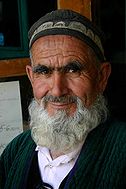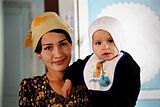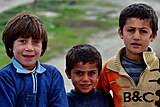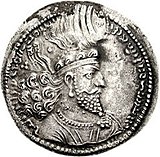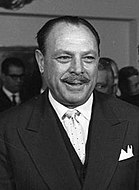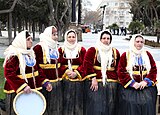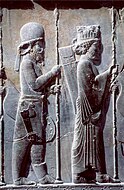İrandilli
İrandilli xalqlar və ya İran xalqları[1] — İran dillərini istifadə etmələri və digər mədəni oxşarlıqlar ilə müəyyənləşdirilən müxtəlif bir Hind-Avropa etno-linqvistik qrupu. Hal-hazırda İran, Əfqanıstan, Tacikistan, Pakistan, Türkiyə, İraq, Suriya, Oman, Özbəkistan, Çin, Ermənistan, Azərbaycan, Hindistan, Gürcüstan, Macarıstan və Rusiyada yaşayırlar.

|
| İran dillərinin yayılması |
| Ümumi sayı |
|---|
| 210-230 milyon |
| Dili |
| Dini |
|
İslam (Şiə İslamı, və Sünni İslamı) |
Proto-iranlıların eramızdan əvvəl II minilliyin ortalarında Mərkəzi Asiyada hind-iranlıların ayrıca bir qolu kimi meydana çıxdıqları güman edilir. Eramızdan əvvəl I minilliyin ortalarında genişlənmənin zirvəsində İran xalqlarının ərazisi qərbdə Dunay düzənliyindən şərqdə Ordos yaylasına və cənubda İran yaylasına qədər bütün Avrasiya çölünü əhatə edirdi.[2]
İran dili danışan xalqarın ümumi əhali sayı təxminən 210-230 milyondur.
Qədim İrandilli xalqlar
[redaktə | mənbəni redaktə et]Müasir İrandilli xalqlar
[redaktə | mənbəni redaktə et]Qalereya
[redaktə | mənbəni redaktə et]- İrandilli xalqlar
-
Pakistandan olan Pamiri qızı
-
Tacik kişi
-
Tacik qadın və uşaq
-
Türkiyənin Bismil vilayətindən olan üç Kürd uşaq
-
Osmanlı imperiyasındakı Kürdlər
-
Osetin Kosta Xetaqurov
-
Puştun Eyyub xan
-
Talış qadınları
-
Bir Midiya əsgəri və bir Fars əsgəri
İstinadlar
[redaktə | mənbəni redaktə et]- ↑ Frye, R. N. "IRAN v. PEOPLES OF IRAN (1) A General Survey". Encyclopædia Iranica. Vol. XIII. pp. 321–326.
- ↑ Harmatta, János (1992). "The Emergence of the Indo-Iranians: The Indo-Iranian Languages" (PDF). In Dani, A. H.; Masson, V. M. (eds.). History of Civilizations of Central Asia: The Dawn of Civilization: Earliest Times to 700 B. C. UNESCO. pp. 346–370. ISBN 978-92-3-102719-2.
- ↑ Encyclopædia Iranica, "CENTRAL ASIA: The Islamic period up to the mongols", C. Edmund Bosworth: "In early Islamic times Persians tended to identify all the lands to the northeast of Khorasan and lying beyond the Oxus with the region of Turan, which in the Shahnama of Ferdowsi is regarded as the land allotted to Fereydun's son Tur. The denizens of Turan were held to include the Turks, in the first four centuries of Islam essentially those nomadizing beyond the Jaxartes, and behind them the Chinese (see Kowalski; Minorsky, "Turan"). Turan thus became both an ethnic and a geographical term, but always containing ambiguities and contradictions, arising from the fact that all through Islamic times the lands immediately beyond the Oxus and along its lower reaches were the homes not of Turks but of Iranian peoples, such as the Sogdians and Khwarezmians."
- ↑ C.E. Bosworth, "The Appearance of the Arabs in Central Asia under the Umayyads and the establishment of Islam", in History of Civilizations of Central Asia, Vol. IV: The Age of Achievement: AD 750 to the End of the Fifteenth Century, Part One: The Historical, Social and Economic Setting, edited by M. S. Asimov and C. E. Bosworth. Multiple History Series. Paris: UNESCO Publishing, 1998. excerpt from page 23: "Central Asia in the early seventh century, was ethnically, still largely an Iranian land whose people used various Middle Iranian languages.
- ↑ الآثار الباقية عن القرون الخالية (p. 47)
- ↑ Rüdiger Schmitt, "Cadusii" in Encyclopedia Iranica[ölü keçid]
- ↑ Robson, Barbara and Lipson, Juliene (2002) "Chapter 5(B)- The People: The Tajiks and Other Dari-Speaking Groups" Arxivləşdirilib 2010-01-27 at the Wayback Machine The Afghans – their history and culture Cultural Orientation Resource Center, Center for Applied Linguistics, Washington, D.C., OCLC 56081073 Arxivləşdirilib 2020-07-13 at the Wayback Machine
A third group, the Farsiwan (also called Parsiwan or Parsiban) are farmers who live near the Iranian border, although some have moved east to the larger towns of Herat, Kandahar, and Ghazni. The Farsiwan, who number about half a million, are ethnically and linguistically indistinguishable from the Iranians across the border.

